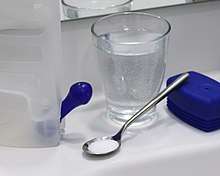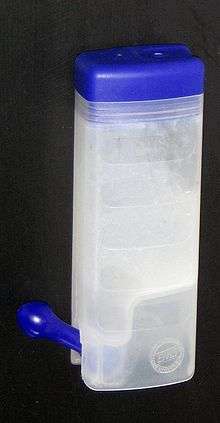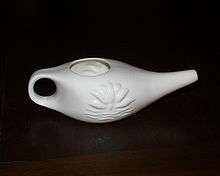Nasal irrigation
Nasal irrigation (also called nasal lavage, nasal toilet, or nasal douche) is a personal hygiene practice in which the nasal cavity is washed to flush out mucus and debris from the nose and sinuses. The practice is reported to be beneficial with only minor side effects. Nasal irrigation can also refer to the use of saline nasal spray or nebulizers to moisten the mucous membranes.
| Nasal irrigation | |
|---|---|
Woman flushing her nose with a neti pot | |
| ICD-9-CM | 22.0 |
| MeSH | D055556 |
Medical uses


Nasal irrigation can be an effective therapy to relieve symptoms of both chronic sinusitis as well as acute sinuitis caused by upper respiratory tract infections such as the common cold.[1] The evidence for use in chronic sinusitis is weak.[2]
It can also be useful for the temporary relief of the symptoms associated with allergic rhinitis.[3]
Adverse effects
Adverse effects include nasal irritation, nosebleeds, headache, and drainage after the irrigation is done. It is generally well-tolerated.[2]
There is a risk of infection if the water is not sterile or the device is not cleaned after use. If the device is used improperly this can be harmful.[4] In fact, proper application suggests the use of boiled water or saline water. In 2018, a patient was reported to have contracted Balamuthia mandrillaris after using tap water during nasal irrigation.[5] Rare cases of fatal naegleriasis have occurred due to nasal insufflation of the amoeba Naegleria fowleri from untreated tap water.
Mechanism of action
Flushing the nasal cavity can soothe inflamed tissue and remove irritants like allergens; it may help clear mucus.[2][3]
Solutions and devices
Solutions
The water should not be tap water, which may contain small amounts of bacteria that are safe to drink but may be dangerous in the nose. The water should be sterile or filtered for micro-organisms; if tap water is used it should be boiled.[4] Saline solution is also sometimes used.[2]
A number of other compounds may be included in irrigation fluids such as the steroid budesonide in an effort to treat chronic rhinosinusitis.[6]
Devices

Neti pots are commonly used and rely on gravity and head position in order to rinse the outer sinus cavities. Typically they have a spout attached near the bottom, sometimes with a handle on the opposite side.[4]
Various squeeze bottles for nasal irrigation have also been used to apply the water.[4]
Bulb syringes are commonly used for infants and children.[4]
There are also irrigation machines available that utilize electric motor-driven pumps.[4]
History
The earliest record of nasal irrigation is found in the ancient Hindu practice of Indian Ayurveda whose roots are traced to the Vedas. It was customary to perform jala-neti daily, as part of soucha (personal hygiene according to scriptures). Jala-neti, which means to cleanse the nose with water, is an old yogic technique from India. The container used to administer the saline is called a "neti pot". This process removes mucus and dirt and clears the nose. A second neti technique known as sutra neti uses a piece of string instead of water.
See also
- Post-nasal drip
- Neti (Hatha Yoga)
References
- Rosenfeld, RM; Piccirillo, JF; Chandrasekhar, SS; Brook, I; Ashok Kumar, K; Kramper, M; Orlandi, RR; Palmer, JN; Patel, ZM; Peters, A; Walsh, SA; Corrigan, MD (April 2015). "Clinical practice guideline (update): adult sinusitis executive summary". Otolaryngology–Head and Neck Surgery. 152 (4): 598–609. doi:10.1177/0194599815574247. PMID 25833927.
- Chong, LY; Head, K; Hopkins, C; Philpott, C; Glew, S; Scadding, G; Burton, MJ; Schilder, AG (26 April 2016). "Saline irrigation for chronic rhinosinusitis" (PDF). The Cochrane Database of Systematic Reviews. 4: CD011995. doi:10.1002/14651858.CD011995.pub2. PMID 27115216.

- Hermelingmeier, Kristina E.; Weber, Rainer K.; Hellmich, Martin; Heubach, Christine P.; Mösges, Ralph (1 September 2012). "Nasal irrigation as an adjunctive treatment in allergic rhinitis: a systematic review and meta-analysis". American Journal of Rhinology & Allergy. 26 (5): e119–125. doi:10.2500/ajra.2012.26.3787. ISSN 1945-8932. PMC 3904042. PMID 23168142.
- "Is Rinsing Your Sinuses Safe?". FDA. 24 January 2017.
- "Fatal Balamuthia mandrillaris brain infection associated with improper nasal lavage". IJID Online. International Journal of Infectious Diseases. December 2018.
- Thaler, Erica; Kennedy, David W. (2009). Rhinosinusitis: A Guide for Diagnosis and Management. Springer Science & Business Media. p. 82. ISBN 9780387730622.
External links
| The Wikibook Ethnomedicine has a page on the topic of: Saline Nasal Wash |